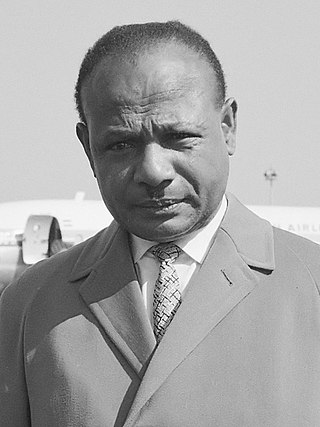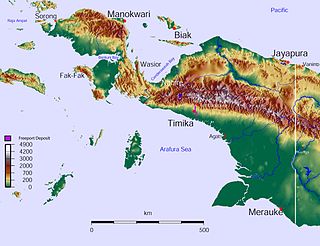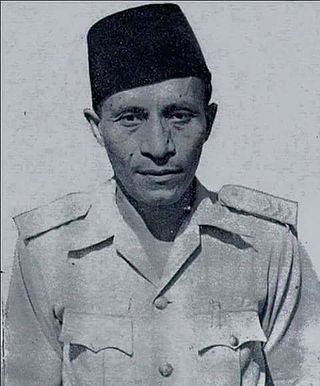
West Papua, formerly Irian Jaya Barat, is an Indonesian province located in Indonesia Papua. It covers most of the two western peninsulas of the island of New Guinea: the eastern half of the Bird's Head Peninsula and the whole of the Bomberai Peninsula, along with nearby smaller islands. The province is bordered to the north by the Pacific Ocean, to the west by Southwest Papua Province, the Halmahera Sea and the Ceram Sea, to the south by the Banda Sea, and to the east by the province of Central Papua and the Cenderawasih Bay. Manokwari is the province's capital and largest city. With an estimated population of 569,570 in mid-2023, West Papua is the least populous province in Indonesia after South Papua, following the separation off in 2022 of the western half of the Bird's Head Peninsula to create the new province of Southwest Papua, containing 52% of what had been West Papua's population. Its population density is similar to Russia.

Western New Guinea, also known as Papua, Indonesian New Guinea, and Indonesian Papua, is the western half of the island of New Guinea, formerly Dutch and granted to Indonesia in 1962. Given the island is alternatively named Papua, the region is also called West Papua.

Salawati is one of the four major islands in the Raja Ampat Islands in Southwest Papua, Indonesia. Its area is 1,623 km2. Salawati is separated from New Guinea to the southeast by the Sele Strait, and from Batanta to the north by the Pitt Strait.

Frans Kaisiepo was an Indonesian Papuan. He served as the fourth Governor of Papua Province. In 1993, Kaisiepo was posthumously declared a National Hero of Indonesia for his lifelong efforts to unite West Irian with Indonesia. As the representative of Papua province, he was involved in the Malino Conference, where the formation of the United States of Indonesia was discussed.

The Papua conflict is an ongoing conflict in Western New Guinea (Papua) between Indonesia and the Free Papua Movement. Subsequent to the withdrawal of the Dutch administration from the Netherlands New Guinea in 1962 and implementation of Indonesian administration in 1963, the Free Papua Movement has conducted a low-intensity guerrilla war against Indonesia by targeting its military and police, along with ordinary Indonesian civilians.

Nicolaas Jouwe was a Papuan leader who was selected to be vice president of the New Guinea Council that governed the Dutch colony of Netherlands New Guinea. As the president of the New Guinea Council was the Dutch civil servant Frits Sollewijn Gelpke, Jouwe was the highest ranking Papuan politician in the colony.

Operation Trikora was a combined Soviet-Indonesian military operation which aimed to seize and annex the Dutch overseas territory of Netherlands New Guinea in 1961 and 1962. After negotiations, the Netherlands signed the New York Agreement with Indonesia on 15 August 1962, relinquishing control of Western New Guinea to the United Nations.
National Hero of Indonesia is the highest-level title awarded in Indonesia. It is posthumously given by the Government of Indonesia for actions which are deemed to be heroic, defined as "actual deeds which can be remembered and exemplified for all time by other citizens" or "extraordinary service furthering the interests of the state and people". The Ministry of Social Affairs gives seven criteria which an individual must fulfill, as follows:
- Have been an Indonesian citizen who is deceased and, during his or her lifetime, led an armed struggle or produced a concept or product useful to the state;
- Have continued the struggle throughout his or her life and performed above and beyond the call of duty;
- Have had a wide-reaching impact through his or her actions;
- Have shown a high degree of nationalism;
- Have been of good moral standing and respectable character;
- Never surrendered to his or her enemies; and
- Never committed an act which taints his or her legacy.

Major TNI Johannes Abraham Dimara was an Indonesian National Hero from Papua.

Major TNI Marthen Indey (1912–1986) was a colonial police officer in New Guinea, Dutch East Indies who later became nationalist fighter in the Indonesian National Revolution and a supporter of Papua becoming part of Indonesia. He was declared a National Hero of Indonesia in 1993 along with two other people of Papuan descent, Frans Kaisiepo and Silas Papare.

Silas Ayari Donrai Papare was a Papuan–Indonesian politician and guerilla leader who is a National Hero of Indonesia.

The West New Guinea dispute (1950–1962), also known as the West Irian dispute, was a diplomatic and political conflict between the Netherlands and Indonesia over the territory of Dutch New Guinea. While the Netherlands had ceded sovereignty over most of the Dutch East Indies to Indonesia on 27 December 1949 following an independence struggle, it retained control over its colony on the western half of New Guinea. The Indonesian government claimed this territory as well, on the basis that it had belonged to the Dutch East Indies and that the new Republic of Indonesia was the legitimate successor to the former Dutch colony.

West Irian Liberation Monument is a postwar modernist monument located in Jakarta, Indonesia. It is located in the center of Lapangan Banteng in Sawah Besar, Central Jakarta. Sukarno, then President of Indonesia, commissioned the monument in 1963 following the West New Guinea dispute in which Indonesia received the territory of Western New Guinea from the Netherlands.

The Indonesian Irian Independence Party was a pro-Indonesian party in Dutch New Guinea. The party was established in 1946 by several pro-Indonesian students as a way to support the integration of Papua into the territory of Indonesia. The party's leader, Silas Papare, was posthumously declared a National Hero of Indonesia on 14 September 1993.

Sultan Zainal Abidin Alting Syah was the 26th Sultan of Tidore in Maluku Islands, reigning from 1947 to 1967. He was also the appointed Governor of Irian Barat in 1956–1962 before the actual inclusion of Irian Barat in Indonesia, serving official Indonesian claims against Dutch colonial rule.

Izaac Hindom was an Indonesian bureaucrat and politician who served as the governor of Irian Jaya from 1982 until 1988.

The Kingdom of Kaimana or Kingdom of Sran is one of the oldest Muslim kingdoms in West Papua, Indonesia. The kingdom was established by Imaga, with the title Rat Sran Nati Pattimuni, traditionally in 1309.
Abdul Hakim Achmad Aituarauw was an Indonesian Papuan former legislative member of DPR West Papua, a legislative candidate for DPR-RI West Papua and also the former king of Kingdom of Kaimana in West Papua, Indonesia.

Southwest Papua is the 38th province of Indonesia to be created, and was split off from West Papua on 8 December 2022. Despite being named southwest, it is a misnomer and this province is actually located in the northwest edge of Papua. The province comprises the Greater Sorong area which consists of Sorong City, Sorong Regency, South Sorong Regency, Maybrat Regency, Tambrauw Regency, and Raja Ampat Regency. The Bill (RUU) on the Establishment of the Southwest Papua Province was passed into law and therefore it became the 38th province in Indonesia with effect from 8 December 2022.
The Kingdom of Sekar, formerly called the Kingdom of Kabituwar, is one of the nine kingdoms that still exist in West Papua Province. The other eight kingdoms are Ati-Ati, Patipi, Rumbati, Fatagar, Arguni, Wertuar, Namatota, and Komisi. This kingdom is located on the Onin Peninsula, Kokas district, Fakfak Regency, West Papua. In the early period, Sekar was a subordinate to the Kingdom of Rumbati, but later it was recognized as its own kingdom.


















